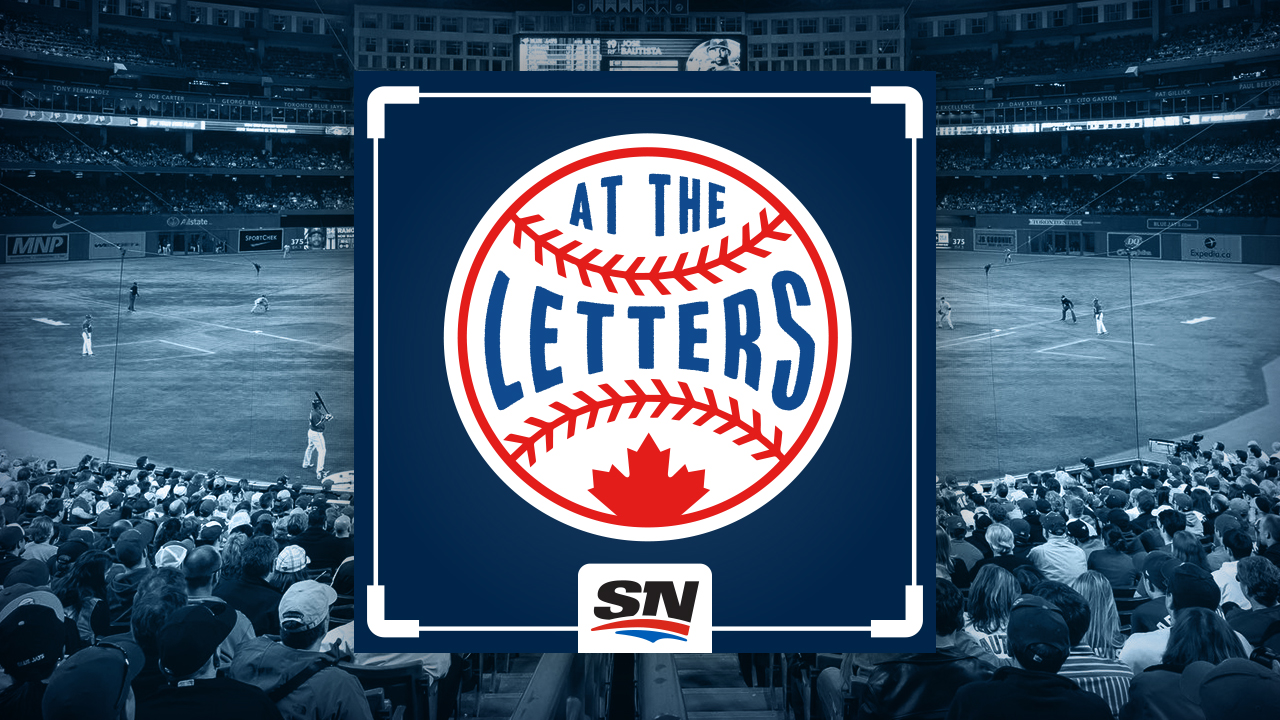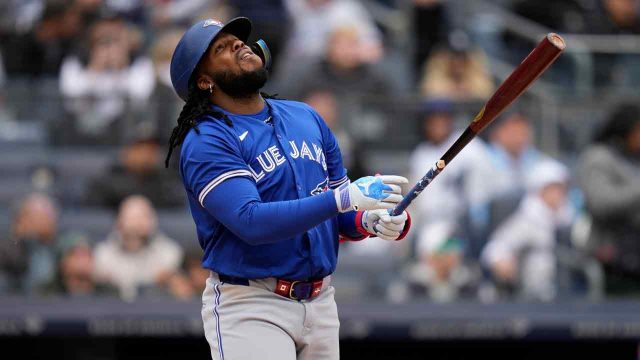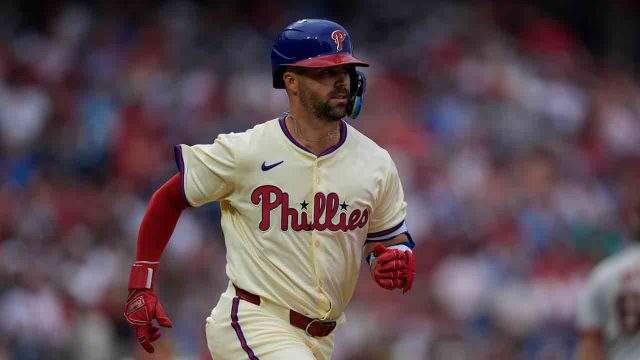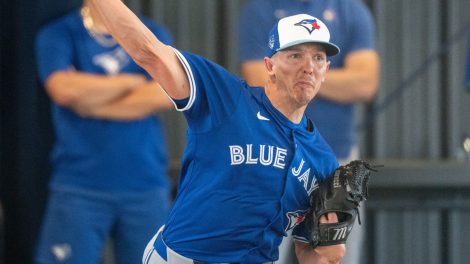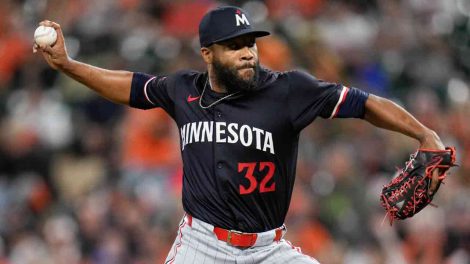PHILADELPHIA — There’s no need to overcomplicate this. The Toronto Blue Jays are underperforming because George Springer, Bo Bichette and Vladimir Guerrero Jr. are underperforming.
The club’s bullpen needs to be healthier and more effective; its starters must be more consistent; its defence ought to be tighter. But the biggest driver of this club’s success are the three hitters who made the most plate appearances for it last season. The three who, so far, are leading the Blue Jays in plate appearances again. The three it bet a quiet off-season on improving. We knew this in February.
If Springer’s going to OPS .574, if Bichette’s going to hit .191, if Guerrero’s going to have as many homers as Michael Toglia and half as many as Cristopher Morel, the Blue Jays simply won’t succeed. The contributions of those three are elemental. And the contributions thus far haven’t been good enough.
Toronto’s two-game series this week with the Phillies, which they split with a 5-3 win Wednesday afternoon, was a decent little microcosm. On Tuesday, Springer, Guerrero, and Bichette went a combined 1-for-11 with a walk and saw an average of 3.5 pitches in their 12 plate appearances. Jose Berrios got rocked, which was obviously an issue. But he could’ve allowed two runs in a complete game and the Blue Jays still would’ve lost.
On Wednesday, Springer, Guerrero, and Bichette went a combined 5-for-14 with two runs driven in and a series of critical plays in timely spots. In the third, Springer — playing through an illness that nearly held him out of the game — shot a fastball the other way, stole second, and scored when Guerrero smoked one of his three hits on the day to left-centre at 115.3-mph. Bichette had his biggest swing in weeks, flicking a 1-1 Aaron Nola fastball the other way with two runners in scoring position to break a tied ballgame in the sixth.
And the rest of the lineup did just enough supporting work — particularly Davis Schneider, who went 2-for-3 and drove another run in behind Bichette in the sixth, and Kevin Kiermaier, who had three hits and plated a pair from the nine hole.
“It would’ve been easy today, I think, for some guys to lay down and say, ‘All right, we’re in the s—. Let’s get home.’ And nobody did that,” Blue Jays manager John Schneider said. “It was kind of a look yourself in the mirror and come out and show up day. … Kind of a gut-check win. And the guys were up for it today.”
On the mound, Chris Bassitt reached deep into his bag for all eight pitches he throws to contain MLB’s winningest team to two runs on three hits and two walks with six strikeouts over 6.1 innings. He threw first-pitch strikes to 14 of 24 hitters, earned 16 whiffs and kept a lineup that had won 11 straight at home with a +71 run differential off balance all afternoon.
“They have so many good hitters in their lineup. So, it was just mix things up, not let them hunt specific speeds,” Bassitt said. “Really just made them uncomfortable.”
Bassitt ran into some trouble in the third, loading the bases with none out thanks to two walks and a soft single. But he contained the damage to only a run against the top of the Phillies lineup, using a cutter to induce a Kyle Schwarber sacrifice fly that Springer made an all-out diving grab on in foul territory, a sinker to get a JT Realmuto force out that was nearly a double play, and a sweeper to get Bryce Harper to fly out to the warning track in right. It certainly appeared skillful, even if Bassitt didn’t see it that way.
“Yeah, I got lucky. I made a bad pitch and Harper almost hit a home run,” he said. “But got out of that.”
Bassitt struck out the side with three different pitches — cutter, curveball, sweeper — in the fifth, carved through the sixth on nine pitches, and worked into the seventh for the third time this season. One of the two runners he left in scoring position when he departed at 102 pitches with one out in that seventh frame crossed the plate while he watched from the dugout. But all in all, a vintage Bassitt performance.
Meanwhile, Guerrero’s three-hit day continued a quietly-strong run going 14-for-40 over his last 10 games. The Blue Jays still need more power from Guerrero, who has only four homers on the season, but they’re in no position to turn a nose up at the .909 OPS he’s provided over this stretch. And if Bichette, who’s seemed ripe to emerge from his confounding slump for several games now, can use Wednesday as a turning point, all the better.
“We know how Bo’s feeling. He knows how he’s feeling. But to get that hit there, kind of a Bo special, line drive to right field for an RBI, it’s huge,” Schneider said. “He’s going to get going. It’s just a matter of time.”
But Springer’s another matter. Credit him for finding ways to contribute on a day that he, as Schneider put it, “was feeling like crap and laying it out there.” He was the catalyst in the third, and his play on Schwarber’s flare in foul territory reiterated there’s no questioning his commitment and capability defensively.
But his wRC+ still dropped on the day to 69, which ranks within the bottom 12 per cent of qualified hitters. It also ranks second-last to Sal Frelick among the 28 players to make at least 65 plate appearances as a club’s leadoff hitter this season.
Schneider is obviously aware of this. And he’s obviously considered making a change atop his lineup — it’s his job to consider everything. But he says he’s yet to broach the topic of moving down in the order with Springer, as he did with Bichette last week before dropping him from the No. 3 spot.
“George needs to get going. I think everyone knows that. He knows that. We’ll see. You always trust the guy that has been there and done that,” Schneider said before Wednesday’s game. “Him and Bo, they’re grinding. And I think it’s easy to say, ‘Oh, well, you moved Bo down. Why not move George down?’
“But you watch and you make the best decision that you can. And if there’s a time to change the lineup, there’s a time to change the lineup. With everyone else and who we have doing what they’re doing right now, you have to try to base it off of that, too. And then where does everyone else fit in? So, I think what it comes down to is they know that they need to be better than what they’ve shown. And we’re giving them the opportunity to do that.”
To this point, Springer has not rewarded Schneider’s faith. After Wednesday, his wRC+ is second-lowest to Bichette among the nine Blue Jays to go to the plate at least 70 times this season. He’s averaging 3.6 pitches per plate appearance — again, second-lowest to Bichette and south of the 3.9 MLB average. Tuesday, he went 1-for-4 with a single while seeing 9 pitches over his four plate appearances. Wednesday, it was 1-for-5 with a single while seeing 20 over five.
Of course, the alternatives matter. The Blue Jays don’t roster a prototypical leadoff hitter. Justin Turner might be the closest they have, but his run-production has been valuable in the heart of the order.
Davis Schneider is contributing some of the best plate appearances on the team of late but also carries one of its lowest contact rates — and is he best left producing right where he is rather than adopting the pressure of table-setting atop the order? We saw last year how the expectations of batting cleanup altered Daulton Varsho’s production. He’s another option, but presents some of the same contact issues as Schneider. And if you went with Varsho against righties, what are you doing against lefties?
There are no easy solutions. But if Springer’s struggles continue, they’ll eventually compel the Blue Jays to try one. There’s just no telling when that juncture will arrive.
“There’s never a time frame on it,” Schneider said. “You just watch, and if it continues to unfold the way it’s been and it’s not working, and you get to the point where you’re banging your head against the wall, then, yeah, you move things around.
“There’s other people that can lead off. I’m well aware of that. If we want to get to where we want to get to, we need George and Bo to perform how they’ve always performed. We’re being a little bit patient with it right now. And hopefully, it turns.”
Meanwhile, there have been plenty of examples of the Blue Jays trying to force themselves from this rut — just not as glaring as dropping a four-time All-Star and two-time Silver Slugger from a premium lineup position.
The Blue Jays met as a team following Tuesday’s 10-1 loss to the Phillies, a session that was described as productive. Games aren’t won or lost in clubhouses. But after a night in which 18 of Toronto’s 33 plate appearances ended in three pitches or fewer, it was probably a good time for everyone to get together and remind each other that even when results aren’t coming easily, process must remain sound.
The coaching staff and front office has tried pulling levers, as well:
Earlier this season, Schneider, a dead fastball-hunter with one hit off a right-handed curveball since he reached the majors, wouldn’t have been in the lineup Wednesday against Aaron Nola, a righty who leans on a curveball with a +84 run value over his career, making it one of the five most effective breaking balls any pitcher has thrown in the Statcast era.
But Schneider’s been swinging it all season — whether that’s due to the optimal situations he’s been exposed to or in spite of them is a matter of opinion. Either way, Schneider’s suddenly an everyday player being thrust into disadvantageous matchups regularly, while Cavan Biggio’s been to the plate only five times this month.
Last month, when Kevin Kiermaier hit the IL, the Blue Jays didn’t call up Nathan Lukes, a capable contact hitter who plays strong defence and runs the bases well. They called up Addison Barger, a 24-year-old third baseman with an aggressive, all-or-nothing swing, despite Lukes presenting a much cleaner roster replacement for Kiermaier.
But Barger had been tearing the cover off the ball at triple-A and the club was willing to weaken themselves defensively — they started Barger in left field, a position he’d never played in his life — to open up the possibility of Barger running into a couple in his first exposure to big-league pitching. He’s now back in the minors after going 1-for-18 and committing two errors.
Two weeks ago, the Blue Jays wouldn’t be pushing the 39-year-old Turner into the field at third base, making only his 11th start at the position since the beginning of 2023, in order to get Danny Jansen’s bat in the lineup at designated hitter in a night game prior to a day game he was scheduled to catch.
But Jansen’s one of the few Blue Jays driving the ball with consistency, so the club’s finding ways to get him in the lineup on days Alejandro Kirk’s catching, even if it means starting MLB’s oldest player at the hot corner behind Jose Berrios, who has a 46 per cent groundball rate.
A week ago, Bichette wasn’t being dropped to sixth in the batting order in favour of Varsho. Schneider was still sticking with Bichette at the top of his order, trusting that a player who’s batted .298/.339/.476 while playing every day over the last three seasons would get it going at the plate.
But Bichette entered Wednesday hitting below .200 while Varsho had four hits in his last three games — so, Bichette started a game in his lowest batting order position since August 2022, and Varsho was pushed to the top of the lineup, where he came out of his approach and struggled in 2023.
Not even six weeks into the season, the Blue Jays are behaving differently than they came into 2024 intending to. They are making decisions that go against the data they’d prefer to let guide their decision-making. They’ve been pushing and pulling all around the margins, vainly searching for a spark to get their lineup going.
It hasn’t worked. Not for a lack of creativity; not for an unwillingness to accept risk; not for fear of putting players in uncomfortable positions. It hasn’t worked because the core problem behind this team’s struggles — a lack of production from Springer, Bichette, and Guerrero — has persisted.
But next may be the biggest lever-pull yet — removing Springer from the leadoff spot. It’s a move Schneider made when the 34-year-old outfielder was scuffling last summer, dropping him to the middle of the order for four weeks in favour of a surging Whit Merrifield before Springer returned to the top of the lineup for the stretch run. But it’s also one Schneider’s been reticent to make since, affording patience to a slumping hitter with a career 129 wrC+. The question is when his patience runs out.


